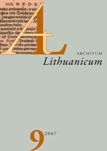Jono Bretkūno Postilės (1591) sklaidos istorija: egzemplioriai Krokuvoje
History of the distribution of Jonas Bretkunas's Postilla (1591): Copies in Krakow
Author(s): Ona AleknavičienėSubject(s): Cultural history, Preservation, Lithuanian Literature, 16th Century
Published by: Lietuvių Kalbos Institutas
Keywords: Jonas Bretkunas; Postilla; 16th century; Krakow; Lithuanian literature;
Summary/Abstract: This article continues research on the distribution of surviving copies of Jonas Bretkūnas’s Postilla (1591). I analyze three copies that are held in Kraków: (1) In the Jagielony library (Biblioteka Jagiellońska; BJ : Cim. Qu 5164); (2) In the Library of Czartorysky (Muzeum Narodowe w Krakowie, Biblioteka XX . Czartoryskich; BCzart: 843 II Cim); (3) In the museum of Czapski (Muzeum Narodowe w Krakowie, Muzeum im. Emeryka Hutten- Czapskiego; BCzap: XVI 350). All three copies of the Postilla reached Kraków in the nineteenth century: (1) the first one was acquired in 1869 by the Jagielony library; (2) the second was brought in together with the library of Czartoryski dukes in 1876; (3) the third one―together with the library of Emeryk Hutten-Czapski in 1894. The copies that are held in Lithuania have reached libraries at a later time―in the twentieth century, between 1918 and 1956 (copies that were known earlier, like the copy from the Vilnius Public Library [mentioned in 1883], and the copy from Simonas Daukantas [donated in 1911 to the Association of Lithuanian Science] disappeared). Two out of the three copies held in Kraków used to be part of private libraries―the library of the Czartoryski dukes in Puławy (from 1813; where it was kept after the Revolution of 1830–31 is unknown) and the library of Czapski in Stankawa (about 1880). Later those copies became the public property of Kraków―Czartoryskis’s in 1876, Czapskis’s in 1903. These two copies came to belong to public libraries due to the efforts of librarians and collectors. In Lithuania at least six out of ten copies reached public libraries because of the librarians and collectors. Both in Poland and in Lithuania the interest in collecting these books is similar―scholarly and cultural heritage.
Journal: Archivum Lithuanicum
- Issue Year: 2007
- Issue No: 09
- Page Range: 57-98
- Page Count: 42
- Language: Lithuanian

